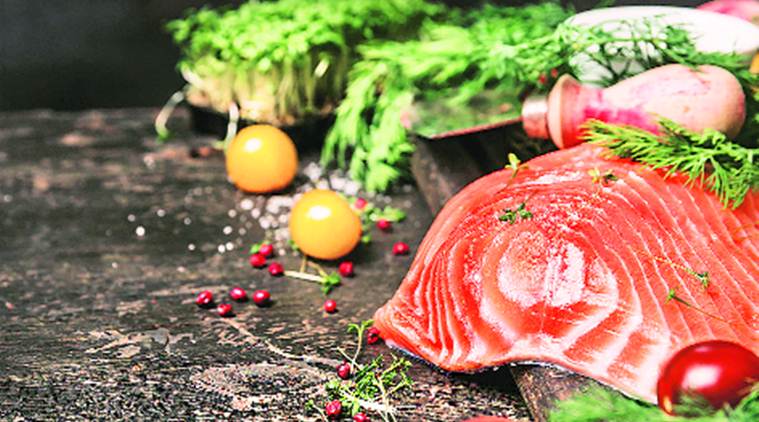Diet diary: Why haemoglobin levels may not be measure of iron status
Non-anaemic iron deficiency was suggested as a causative factor for diffuse hair loss in women in 1963. Since then, numerous studies have evaluated the associations between decreased iron and hair loss.
 Non-anaemic iron deficiency was suggested as a causative factor for diffuse hair loss in women in 1963.
Non-anaemic iron deficiency was suggested as a causative factor for diffuse hair loss in women in 1963.
If you thought that your haemoglobin levels are a measure of your iron status, think again! While haemoglobin reflects whether an individual is anaemic or not, it may or may not necessarily be an indicator of your body’s iron stores. You may have normal haemoglobin levels and still have iron deficiency, also referred to as non-anaemic iron deficiency.
Non-anaemic iron deficiency was suggested as a causative factor for diffuse hair loss in women in 1963. Since then, numerous studies have evaluated the associations between decreased iron and hair loss. Iron is stored in the body as ferritin. During early stages of iron deficiency, a decreased serum ferritin level is a sign of decreased iron stores. Ferritin accounts for 20 per cent of total iron in adults and plays an important role, both in absorption and recycling of iron, and is formed by intestinal mucosa, liver, spleen and bone marrow.
Ferritin levels are a good indication of iron storage levels. Low ferritin levels indicate depleted iron reserves, while high ferritin levels indicate inflammation and can be a risk factor for cardiovascular disease and diabetes. A higher-than-normal ferritin level may be due to any inflammatory condition, alcoholic liver disease, frequent blood transfusion or too much stored iron in the body (hemochromatosis). Hair fall, hair thinning, hair loss (alopecia) and dull lifeless hair and lightening of dark hair can be linked to low ferritin levels.
Low iron stores or ferritin have been considered a possible contributing factor in several other conditions — muscle weakness, aching joints, breathlessness or heart palpitations, difficulty in swallowing (dysphagia), dry skin, sensitivity to cold temperature; pale pallor, thin, soft or brittle nails that don’t grow or may ’spoon’, ‘curl’-up or split, meaty tongue and a pale conjunctiva under the eye lids. Since iron is one of the key nutrients to ‘switch on’ cellular functions, low levels effect brain function as well. Brain fatigue, light headedness, headaches, depressed or disturbed mood (anxiety), sleep disturbances, mood alterations, increased aggressiveness, impatience, intolerance, or anxiety are common features.
Iron deficiency is also known to depress the immune system, making the body more vulnerable to infection — particularly thrush, chronic herpes, mouth ulcers or chronic ear infections. Also, thyroid, para-thyroid and adrenal gland function are also influenced by an imbalance of iron. Ammehorea (loss of menstrual cycles) is also seen with low iron stores. A poorly understood behaviour seen among iron deficient people is pica- the craving and consumption of ice, chalk, starch, clay, soil and other non-food substances.
Most common effects of low ferritin levels include heavy menstrual bleeding, crash dieting, poor diets, parasitic infections, surgeries, severe illnesses, digestive tract bleeding, emotional stress, medications, certain health conditions like malabsorption and thyroid abnormalities or hormonal changes. Hormonal changes are a common cause of low ferritin levels among females, particularly after pregnancy, following discontinuation of birth control pills or during menopause.
High doses of Vitamin A supplements, blood pressure and gout medications may interfere with iron absorption and hence cause hair loss. Excessive or prolonged intake of certain supplements including vitamins B12, D, E, zinc, calcium, copper, magnesium or chromium antagonise the absorption of iron and may contribute to iron deficiency. While these nutrients are important, supplementation with ferritin should be done with care for efficient body functioning. Interestingly, obesity and iron deficiency are the two most common nutritional disorders worldwide and studies found a higher rates of iron deficiency in obese than normal-weight individuals.
Iron rich foods include animal foods — meat, especially organ meat (liver), poultry & fish and green leafy vegetables including cauliflower greens, mustard greens, radish leaves, amaranth (chaulai), lotus stem, black gram, black sesame, seaweed, black beans, soybean, water melon, grains like quinoa and some dry fruits like dates and sultanas.
Iron is absorbed 2-3 times more efficiently when taken with foods high in vitamin C like citrus fruits (oranges, lemon, guava), amla, sprouts and some vegetables like tomatoes, cauliflower.



- 01
- 02
- 03
- 04
- 05
























